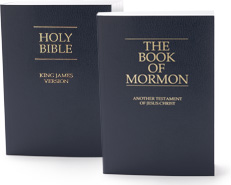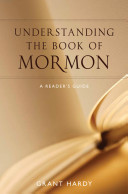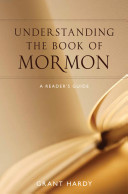Category: Book of Mormon
-
![Book of Mormon Word Cloud [updated]](https://timesandseasons.org/wp-content/uploads/2012/07/WordItOut-Word-cloud-96918.png)
Book of Mormon Word Cloud [updated]
I’ve been curious what a word cloud of the Book of Mormon would look like, so , just for fun on a Friday, I finally made one. I don’t have a lot to say about it, other than that “unto” seems to be a very popular word (which doesn’t really surprise me, but I didn’t…
-
In Memoriam
I spend the morning with my children at the cemetery. The high school band played, the mayor placed a wreath at the war memorial, and servicemen, including a veteran of Pearl Harbor, spoke to us. We bought red paper poppies to pin to our shirts. We didn’t talk about Memorial Day in sacrament meeting yesterday.…
-

The Real World of the Book of Mormon
This is the fourth in a series of posts taking a broad look at the Book of Mormon. This post continues the discussion of the prior post, The Book of Mormon as Narrative, by considering verisimilitude. This term refers to how faithfully a text represents the real world or, to various degrees, depicts events that…
-

The Book of Mormon as Narrative
This is the third post in a series taking a broad view of the Book of Mormon (first, second). In this post I will discuss aspects of narrative encountered in the text. Not all scripture is narrative: consider the lengthy legal codes in the Torah and the moral exhortation found in James. Not all historical…
-
The Book of Mormon: What has it done for you lately?
Julie is posting detailed commentary and Kent is providing literary reflection; I’m afraid all I have to offer on the Book of Mormon is general observations. This week let’s talk about situating the book as a whole, not so much in terms of content and form (which I’ll address in later posts) but in terms…
-

12 Questions with Grant Hardy – part II
Here is the conclusion of Times & Seasons look at Grant Hardy’s new book Understanding the Book of Mormon, and the second half of our 12 Questions interview:
-

12 Questions with Grant Hardy – part I
To cap off our roundtable review of Grant Hardy’s new book Understanding the Book of Mormon we’re fortunate to feature an interview with the book’s author. The interview will be posted in two parts. Our thanks to all who have participated, and especially Bro. Hardy.
-

Grant Hardy and Personal Scripture Study
Every semester, one of my principal goals in my tax classes is to get my students to engage with the Internal Revenue Code. And it’s harder than you might think: often they don’t read the Code itself, focusing instead on the explanations in their casebook.[fn1] And their aversion to reading the Code is completely understandable:…
-
Grant Hardy’s Subject Problem
Criticisms of the Book of Mormon generally fall into one of two categories: objections to its historical claims on the one hand, and on the other critiques of its literary style. The two prongs are often combined in a single attack, for instance in the suggestion that the awkward style of the book reflects the…
-
Royal Skousen’s 12 questions — The Critical Text Version
Last month we posted Royal Skousen’s discussion of his work on recovering the earliest version of the Book of Mormon, along with some updates. Unfortunately, that post garnered some annoying formatting problems — mostly due to the new format T&S adopted this year. We’re happy to now present to you mark III of Royal Skousen’s…
-
12 Questions and a Book by Royal Skousen
5 years ago we published one of my favorite “12 Questions” posts, in which Royal Skousen discussed in some depth what he has learned from his extensive work on the earliest editions of the Book of Mormon. His book, The Book of Mormon: The Earliest Text, is being published in September by Yale University Press…
-
DNA Delight
A recent DNA study has gotten some attention, both on our sidebar and in a post by J. Nelson-Seawright at By Common Consent. The Mormon question that inevitably comes up from such a study is does it cast any light on the question of whether Lehi really landed in the Americas long ago? J. Nelson-Seawright…
-
What Does My Lack of Personal Trials Say About Me?
I’ve been thinking long and hard about what I should talk about in my inaugural post on this blog. Quite honestly, when I agreed to do a stint as a guest blogger, I thought it would be pretty easy. But, lately, it seems that all my Mormonism-related thoughts have been trite and meaningless. For example,…
-
Reading Nephi Reading Isaiah at BYU
This looks like the sort of conference that makes me sad at times that I don’t live in Utah:
-
Getting over Nibley
Of late I have been thinking of late about how to read Mormon scriptures. In particular, I have been working on some passages in the Book of Mormon on legal interpretation and thinking about how best to approach these sections. By and large, it seems to me that there have been three basic models of how to…
-
Commentary on 1 Ne. 17, concluded
Continuing part 1 , part 2, and part 3. Nephi’s response to his brothers directly attacks their understanding of Moses’s significance.
-
Commentary on 1 Nephi 17, pt. 3
Continuing part 1 and part 2. Laman and Lemuel offer up their gloss on the story of Moses in verse 22 and in so doing model a particular type of scriptural and legal interpretation. They say: And we know that the people who were in the land of Jerusalem were a righteous people; for they…
-
Commentary on 1 Nephi 17, pt. 2
Laman and Lemuel make their appearance in chapter 17 in verse 17, where they say:
-
Relics
The Book of Mormon is a reliquary in prose. In some extensive sections and at some critical moments, what drives the narrative is the question: how did a set of golden plates, a steel sword, a ball of curious workmanship, a breastplate, and two translucent stones end up inside a stone box buried in a…
-
Bones
One of the subterranean threads running throughout the Book of Mormon is the mystery of whose bones are heaped upon the land northward.
-
The Canonization of the Book of Mormon?
Penguin Books has just published a “Penguin Classics” edition of the Book of Mormon edited by Laurie F. Maffly-Kipp. Penguin Classics, of course, are the paperback editions of literary staples like Jane Austen or Charles Dickens. They are printed and marketed largely as texts for college classes. The assumption is that a text included in…
-
The War Chapters
And a great sleep did come over the land; yea, verily, there was much dozing and nodding of heads in all of the sabbath schools.
-
Korihor and the United States Reports
Let’s read the Book of Mormon as a commentary on American constitutional law and vice versa. Alma 30:7-10 reads:
-
Egyptian Brass Plates and a naming contest
If this is common knowledge I completely missed it. So I post this in memory of all those who also slept through indecent chunks of early morning Seminary.
-
Amazon’s take on the Book of Mormon
Amazon.com has an algorithm for noting the “Statistically Improbably Phrases” in any given book. The idea is to look for word combinations that are uncommon generally but common in the book in the hope that this provides potential buyers some insight into what the book is about. Here are the ones for the Doubleday edition…
-
Testifying of historicity
As I was re-reading conference, I came across this closing statement by President Hinckley:
-
Prophecy vs. History
Not too long ago, I stumbled across the PBS presentation of Jared Diamond’s book Guns, Germs, and Steel (2d ed. 1999). It reminded me of dealing with the book at college and enjoying the ideas presented and the sweeping take of world history that it offered. But while watching the presentation and contemplating the message…
